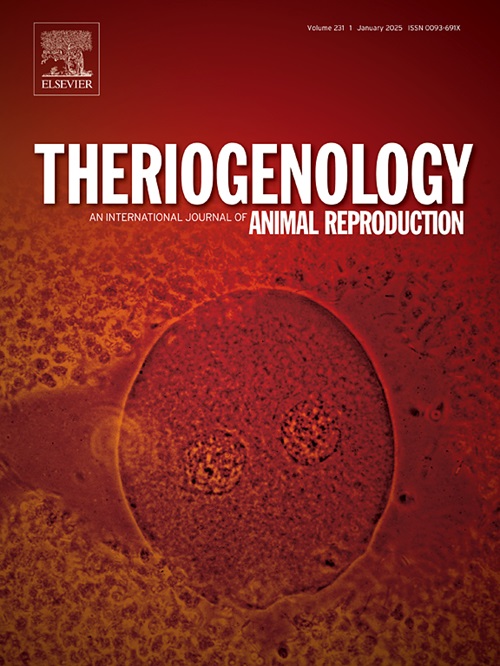Beyond the scrotal circumference: Exploring phenotypic, nutritional and metabolic traits associated with early sexual development in young Nelore (Bos indicus) bulls
IF 2.4
2区 农林科学
Q3 REPRODUCTIVE BIOLOGY
引用次数: 0
Abstract
This study evaluated the associations among phenotypic, reproductive, nutritional, and metabolic traits with early sexual development in Bos indicus bulls. A total of 128 prepubertal Nelore bulls (11.1 ± 0.1 months old) were evaluated in an automatic feedlot system during a 70-day period. Parameters assessed on days −70 (beginning of the feedlot) and 0 (end of the feedlot) included body weight (BW), body condition score (BCS), scrotal circumference (SC), rectal temperature (RT), scrotal surface temperature (SST), testicular parenchyma (via transcutaneous ultrasound) and serum metabolomics. On day 0, bulls were submitted to a seminal analysis and categorized as late maturing (LM; n = 97; <50 × 106 sperm cells per ejaculate) or early maturing (EM; n = 31; >50 × 106 sperm cells per ejaculate, with >10% motility). In addition, feed efficiency traits (average daily gain [ADG], dry matter intake [DMI] and residual feed intake [RFI]) were evaluated during the feedlot period, and ribeye area (REA), rump fat thickness (RFAT), and subcutaneous back fat thickness (BFAT) were assessed on day 0. On day −70, no differences were observed in BW (P = 0.28), BCS (P = 0.38), RT (P = 0.11), SC (P = 0.17) and SST (P = 0.99) between LM and EM bulls. However, EM bulls exhibited more echogenic testicular parenchyma, with fewer black pixels (P = 0.003) and more white (P < 0.001) and gray pixels (P < 0.001). Despite similar seminiferous tubular density (P = 0.11), EM bulls had lower seminiferous tubular area (P < 0.001) and diameter (P < 0.001) than LM bulls. On day 0, EM bulls had greater SC (P = 0.01) and BFAT (P = 0.05), while other traits (BW, BCS, RT, SST, REA, RFAT) remained similar (P > 0.05) between groups. Additionally, no effects on testicular parenchyma were observed. Moreover, EM bulls had a similar ADG (P = 0.15) but tended to have higher RFI (P = 0.06) and DMI (P = 0.10) than those LM. Serum metabolomics on day −70 revealed a clear distinction between LM and EM bulls, with alterations in pathways such as glyoxylate and dicarboxylate metabolism, glycine, serine, and threonine metabolism, and TCA cycle. Likewise, on day 0, metabolic distinction persisted, involving lipoic acid metabolism, glutathione metabolism, and glyoxylate and dicarboxylate metabolism, reflecting energy production and redox regulation, which are critical for early sexual development. In conclusion, metabolomics analysis proved an effective tool for discerning metabolic profile differences between LM and EM bulls. EM bulls showed greater SC and BFAT only on D0, while testicular parenchyma echogenicity was unreliable for predicting early sexual development. Feed efficiency traits, such as RFI and DMI, may influence sexual maturation, highlighting the interplay between nutrition, metabolism, and reproductive development.
阴囊外围:探索与年轻公牛早期性发育相关的表型、营养和代谢特征
本研究评估了印度公牛的表型、生殖、营养和代谢性状与早期性发育的关系。采用自动饲养系统对128头(11.1±0.1月龄)青春期前的Nelore公牛进行了70 d的评估。在- 70天(饲养场开始)和0天(饲养场结束)评估的参数包括体重(BW)、体况评分(BCS)、阴囊围(SC)、直肠温度(RT)、阴囊表面温度(SST)、睾丸实质(经皮超声)和血清代谢组学。第0天,公牛进行种子分析,分类为晚熟(LM;n = 97;每次射精50 × 106个精子细胞)或早熟(EM;n = 31;每次射精50 × 106个精子细胞,活动性为10%)。此外,在饲养期内评估饲料效率性状(平均日增重[ADG]、干物质采食量[DMI]和剩余采食量[RFI]),并在第0天评估肋眼面积(REA)、臀脂肪厚度(RFAT)和皮下背部脂肪厚度(BFAT)。第70天,LM和EM公牛的体重(P = 0.28)、BCS (P = 0.38)、RT (P = 0.11)、SC (P = 0.17)和SST (P = 0.99)均无显著差异。然而,EM公牛表现出更多的睾丸实质回声,黑色像素较少(P = 0.003),白色像素较多(P <;0.001)和灰度像素(P <;0.001)。尽管精管密度相似(P = 0.11),但EM公牛的精管面积较小(P <;0.001)和直径(P <;0.001)比LM牛。在第0天,EM公牛的SC (P = 0.01)和BFAT (P = 0.05)显著增加,而其他性状(BW、BCS、RT、SST、REA、RFAT)保持不变(P >;0.05)。此外,未观察到对睾丸实质的影响。此外,EM公牛的平均日增重相似(P = 0.15),但RFI (P = 0.06)和DMI (P = 0.10)往往高于LM公牛。第70天的血清代谢组学显示,LM公牛和EM公牛之间存在明显的差异,在乙醛酸盐和二羧酸盐代谢、甘氨酸、丝氨酸和苏氨酸代谢以及TCA循环等途径上发生了变化。同样,在第0天,代谢差异持续存在,包括硫辛酸代谢、谷胱甘肽代谢、乙醛酸盐和二羧酸盐代谢,反映了能量产生和氧化还原调节,这对早期性发育至关重要。总之,代谢组学分析被证明是识别LM公牛和EM公牛代谢谱差异的有效工具。EM公牛仅在D0时显示更高的SC和BFAT,而睾丸实质回声不可靠,无法预测早期性发育。饲料效率性状,如RFI和DMI,可能影响性成熟,突出营养、代谢和生殖发育之间的相互作用。
本文章由计算机程序翻译,如有差异,请以英文原文为准。
求助全文
约1分钟内获得全文
求助全文
来源期刊

Theriogenology
农林科学-生殖生物学
CiteScore
5.50
自引率
14.30%
发文量
387
审稿时长
72 days
期刊介绍:
Theriogenology provides an international forum for researchers, clinicians, and industry professionals in animal reproductive biology. This acclaimed journal publishes articles on a wide range of topics in reproductive and developmental biology, of domestic mammal, avian, and aquatic species as well as wild species which are the object of veterinary care in research or conservation programs.
 求助内容:
求助内容: 应助结果提醒方式:
应助结果提醒方式:


